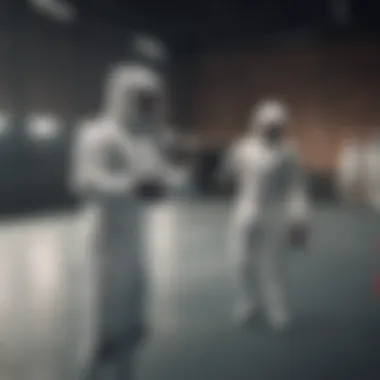The Evolution of R&D in Fencing: Impact and Insights


Intro
The integration of research and development in fencing has been pivotal in modernizing the sport. The way athletes train, the equipment they use, and the strategies they employ all reflect significant advancements driven by scientific inquiry and technological innovation. This article will explore these changes, offering insights into how research and development shapes fencing today.
Key Concepts
Definition of Primary Terms
In the context of fencing, research and development (R&D) encompasses activities that foster innovation in training methods, equipment design, and performance analytics. Key terms in this arena include:
- Fencing: A sport involving the use of swords—such as foil, epee, and sabre—in a combat setting.
- Research and Development (R&D): Systematic activities that lead to new products or procedures, focusing on innovation.
- Performance analysis: The study of athletes' performance metrics to identify strengths and weaknesses.
Related Concepts and Theories
The relationship between R&D and fencing can be further understood through various theories and models:
- Technological Determinism: This theory posits that technological advancements shape social practices, including sports.
- Athlete-Centric Training: Focuses on tailoring training approaches based on individual athlete needs and abilities, often supported by R&D findings.
Research and development in fencing is not merely about creating better equipment or training regimens; it's about understanding the underlying principles that govern athletic performance.
Historical Context of R& in Fencing
The history of fencing is rich with evolution driven by innovations. Initially, training methods were primitive and heavily reliant on tradition. However, as the sport gained popularity, the awareness of the need for structured training and equipment emerged. Scholars and practitioners began exploring methodologies informed by scientific principles. This intellectual shift paved the way for interdisciplinary collaboration among engineers, sports scientists, and coaches.
The shift from traditional practices to research-driven methodologies has resulted in profound changes in how athletes prepare. R&D initiatives have led to more versatile and technically advanced training programs. Understanding the biomechanics of movement and the physics of blade interaction became foundational.
Current Practices and Innovations
In contemporary fencing, there is a clear emphasis on utilizing data and analytics to enhance training. Some notable innovations include:
- Smart Equipment: Sensors integrated into fencing gear to measure speed, force, and other performance metrics in real time.
- Virtual Training Environments: Simulators and virtual reality used in training help fencers practice tactics without the need for physical partners.
- Sports Science Applications: The application of psychology and physiology to optimize an athlete’s mental and physical capabilities.
These advancements illustrate how R&D has redefined the foundation of fencing practice, creating a more scientific approach to athletic training.
Future Directions
Gaps Identified in Current Research
While advancements are evident, there are gaps in understanding the comprehensive impact of R&D in fencing. Most current studies focus on isolated aspects, such as equipment technology, without integrating broader performance metrics.
Suggestions for Further Studies
Future research could explore:
- Longitudinal studies examining the long-term impacts of innovative training methods on performance.
- Cross-disciplinary research integrating psychology, biomechanics, and strategic training to establish best practices.
- Athlete feedback mechanisms assessing personal experiences with new systems.
Through this approach, we can ensure that the evolution of R&D in fencing continues to provide benefits to athletes and coaches, bridging the gap between theory and practice effectively.
"The future of fencing lies not only in the sport itself but in its connection to science and technology."
Intro to R& in Fencing
Research and Development (R&D) in fencing is a critical area of focus that shapes the very essence of the sport. The importance of this topic goes beyond mere interest; it encapsulates the innovative methodologies and technologies that influence training and performance outcomes. R&D allows for a structured approach to improvement, ensuring that athletes can maximize their potential through scientific inquiry and technological advancements.
By exploring R&D, we uncover numerous benefits. Firstly, it aids in the design of advanced equipment, tailored to meet the evolving needs of modern fencers. Parallely, rigorous training programs, informed by scientific principles, enhance skill acquisition and athletic prowess. Evaluating historical contexts shows that fencing has consistently adapted through R&D efforts, enriching its strategies and tactics.


Considerations regarding R&D in fencing include collaboration among various disciplines. Engineers, sports scientists, and fencing coaches must work together to foster innovation that directly impacts performance. Interdisciplinary approaches can lead to breakthroughs that a single discipline might overlook. Furthermore, acknowledging the ethical implications of technology in sports is paramount. Monitoring performance through wearable technology, for example, raises questions regarding athlete privacy and data use. Thus, R&D is a vital aspect of fencing, not only enhancing current practices but also laying the groundwork for sustainable growth in the sport.
Defining Research and Development
Research and Development is a systematic process that focuses on developing new knowledge and utilizing it for practical applications. In the context of fencing, R&D encompasses both theoretical studies aimed at understanding the dynamics of human performance and applied research that translates directly into training methods and equipment innovations. R&D is essential for identifying and resolving performance gaps. It is the bridge connecting theory to practice, allowing fencers to train smarter, and coaches to implement more effective training regimens.
The Historical Context of Fencing
Fencing's historical context highlights a rich lineage intertwined with cultural evolution and warfare. As a sport, it has matured significantly since its military origins. The transition from historical combat techniques to today’s competitive formats necessitated substantial R&D. Early fencing techniques primarily developed through trial and error, grounded in practical combat experiences.
As swordplay became formalized into a competitive sport, fencing masters began documenting techniques and training protocols. This shift relied heavily on anecdotal evidence rather than scientific inquiry, but it set a foundation for future advancements. In the 20th century, as competitive fencing grew globally, a more structured approach to R&D emerged. Performance analysis through video technology and biomechanics began to shape training, making the sport more scientific and efficient. Historical perspectives reveal that R&D in fencing is not just a modern endeavor; it is a continuum that respects traditions while embracing innovation to enhance performance and safety.
The Role of Technology in Fencing
The role of technology in fencing cannot be overstated. It has brought about significant advancements that improve performance, safety, and training methods. As fencing continues to grow as a competitive sport, integrating technology ensures athletes are well-prepared and equipment is at the cutting edge. This amalgamation enhances both the competitive edge of the athletes and the overall experience of the sport.
Innovations in Equipment Design
Innovations in equipment design are pivotal in the evolution of fencing. Traditional fencing gear has progressed considerably, with modern materials offering improved durability, flexibility, and lightweight properties. Materials like carbon fiber and advanced polymers are now common in the production of blades, and these changes contribute to better performance and greater safety for fencers. For example, a well-designed mask must not only protect the athlete but also weigh less to allow for greater mobility.
Further, electronic scoring systems have transformed competitions by ensuring accuracy and faster decision-making. These systems utilize sensors that detect touches with remarkable precision. The shift to electronic scoring is an excellent example of how technology improves both the fairness and the viewer's experience during events. This innovation fosters a more engaged audience, allowing for a clearer understanding of the action.
Wearable Technology for Performance Monitoring
Wearable technology is increasingly becoming an integral part of fencing training. Devices such as heart rate monitors, GPS trackers, and motion sensors offer insights into an athlete's performance metrics. Tracking heart rates during training can help coaches tailor their strategies for physical conditioning. Similarly, motion sensors can analyze a fencer's footwork, providing data that help in refining techniques.
The ability to collect real-time data enables fencers to make quick adjustments. Coaches use this data to help develop targeted training regimens that address specific weaknesses. The integration of wearable tech in training is significant as it promotes personalized development in fencers and optimizes their training efforts.
"Utilizing wearable technology in fencing training can profoundly enhance an athlete's performance by providing critical data for improvement."
In summary, the role of technology in fencing encompasses equipment innovation and advancements in performance monitoring, which can be seen as integral components in the sport's evolution. These innovations not only improve competitive outcomes but also enrich the training experiences of athletes, laying the groundwork for future developments.
Scientific Methods in Training
Scientific methods play a crucial role in modern fencing training. By using systematic approaches, coaches and athletes uncover effective techniques to enhance performance. These methods encompass a range of practices, including biomechanical analysis and psychological evaluations. Together, they create a more effective training regime.
Adopting scientific principles allows trainers to formulate personalized programs. They are not merely based on anecdotal experiences but derive from research findings. This can lead to improved outcomes, as athletes train smarter, not just harder.
Biomechanical Analysis of Movements
Biomechanical analysis focuses on the mechanics of human movement. This is particularly important in fencing where precision and technique are paramount. Using motion capture technology, trainers can analyze the athlete’s movements in great detail. This offers insights into how to improve footwork, blade control, and overall agility.
Athletes receive feedback not just on their speed, but also their positioning and balance. This leads to more effective corrections, reducing injury risk and maximizing performance. By understanding the forces acting on the body during a bout, fencers can adapt their methods to employ more efficient strategies.
"Biomechanical insights can illuminate underlying issues that traditional coaching might miss."
Additionally, biomechanical data can be used to study the differences between beginner and elite fencers. Such analysis helps identify specific areas for improvement, contributing to a tailored training approach.
Psychological Factors in Fencing Performance
Psychological factors also play a significant role in fencing success. The sport demands high levels of concentration, strategy, and mental fortitude. Effective training should include psychological preparation alongside physical conditioning.
Understanding concepts like competitive anxiety, focus, and goal-setting can greatly enhance a fencer's performance. Mental training techniques, such as visualization and mindfulness, can be integrated into daily practice. This combination fosters resilience, helping athletes to perform under pressure.
Coaches can assess mental readiness through questionnaires and observations. This knowledge allows for targeted interventions to bolster an athlete's mindset. For example, a fencer exhibiting anxiety may benefit from relaxation techniques prior to bouts.
Fencers who develop strong psychological strategies often outpace their peers who rely solely on physical training. The mental aspect is thus not just significant; it can often be the distinguishing factor in competitive performance.


Interdisciplinary Collaborations in R&
Research and development in fencing flourishes due to interdisciplinary collaborations. These partnerships enhance innovation by merging knowledge from different fields. Engineers, designers, sports scientists, and coaches contribute vital insights. Their combined expertise leads to advancements in both equipment and training methods. This cooperation helps to address specific challenges faced by fencers and coaches.
Interdisciplinary work is vital for several reasons. First, it fosters diverse problem-solving approaches. Each discipline offers unique perspectives. For instance, engineers apply principles of physics to design safer and more effective gear. Simultaneously, sports scientists analyze performance metrics to suggest improvements. These insights can be instrumental in tailoring training regimens to individual needs.
Furthermore, these collaborations set the foundation for continuous improvement. As new data and technology emerge, the integration of various expert opinions leads to ongoing refinement. This adaptability ensures that the sport evolves in response to modern demands and standards. Ultimately, such partnerships create a feedback loop that enhances athlete performance and safety.
Engagement of Engineers and Designers
The engagement of engineers and designers is pivotal in fencing R&D. These professionals are crucial in developing innovative equipment. Their involvement starts from the conceptual stage to production. Engineers draw upon materials science to create lightweight yet durable weapons and protective gear. Designers, meanwhile, focus on ergonomics and usability. They work to ensure that equipment meets the high demands of athletes while also adhering to safety standards.
Collaborative processes typically include:
- Initial Conceptualization: Ideas are gathered from fencers and coaches about functional needs.
- Prototyping: Engineers create prototypes of new equipment. Designers ensure usability and aesthetics.
- Testing and Feedback: Athletes trial the prototypes, providing valuable feedback for enhancements.
- Final Production: The finalized products must meet rigorous safety standards before hitting the market.
This effective synergy between engineering and design leads to equipment that not only performs well but enhances the overall experience of the sport.
The Influence of Sports Science Research
The influence of sports science research significantly shapes how athletes train and perform. This branch of study provides empirical data on physical and mental aspects of fencing. Such data-driven insights allow coaches and athletes to make informed decisions. Key areas of focus include biomechanics, psychology, and physiology.
Sports scientists employ various methods to conduct research, including:
- Biomechanical Analysis: This evaluates movement efficiency and injury prevention. Understanding biomechanics helps to refine techniques.
- Psychological Research: Mental preparation is equally crucial. Studies on psychology provide insights into concentration and stress management during competition.
- Physiological Assessments: Research here informs training intensity and recovery protocols. It ensures athletes are physically prepared for high-level competition.
The data from sports science is translated into practical training programs. Coaches use these findings to tailor strategies that meet an athlete’s needs. As sports science evolves, so too does the future of fencing. Athletes can harness this knowledge to enhance their skills, pushing the limits of human performance.
Case Studies of R& in Fencing
Exploring case studies of research and development in fencing provides substantial insights into practical applications and real-world transformations in this sport. These case studies illustrate the direct benefits of focused R&D initiatives, showcasing how theory can be effectively translated into practice. By examining specific examples, one can appreciate the intricate relationship between innovation and performance enhancement in fencing.
Successful Equipment Innovations
Equipment has always been a critical aspect of fencing. The design and functionality of gear can influence performance and safety. Over the years, there have been notable innovations in equipment through R&D, fundamentally changing the way fencers train and compete.
One of the prominent advancements is the development of electric scoring systems. The invention of the electric fencing sword, or "épée," has improved accuracy in scoring while making competitions more engaging for audiences. This innovation allows referees to make faster and more accurate calls during matches, thereby enhancing the integrity of the sport.
Another significant innovation is the evolution of protective gear. Modern materials such as Kevlar and specialized composites contribute to lighter and more durable jackets, masks, and gloves. These advancements not only improve comfort but also enhance safety, reducing the risk of injury during high-intensity bouts.
Moreover, research into ergonomic design has led to more user-friendly equipment, minimizing fatigue and optimizing performance. For instance, advancements in grip design ensure that fencers maintain better control and precision, which is vital during competitive scenarios.
Training Programs Adopted by Elite Fencers
The integration of research findings into training programs represents another vital area of development. Elite fencers benefit from sophisticated training regimens that leverage scientific insights into biomechanics and psychology.
Variability in training programs allows for a more personalized approach, accommodating the unique needs and strengths of each athlete. Some organizations utilize biomechanical analysis tools, which provide feedback on movement efficiency and technique. By evaluating footwork and blade movements using video analysis, coaches can identify strengths and weaknesses in a fencer's performance.
Additionally, psychological strategies are increasingly implemented in training. Mental conditioning techniques help athletes enhance focus and resilience during competitions. Research has shown that mental preparation can significantly affect performance outcomes, helping fencers manage stress and maintain composure during high-pressure situations.
By adopting evidence-based practices, elite fencers refine their skills and achieve higher levels of competitive success.
Challenges in R& for Fencing
Research and development play a crucial role in the evolution of fencing as a competitive sport. However, this process is not without its difficulties. Understanding the challenges faced in R&D can shed light on the complexities involved in advancing the sport. It highlights the need for strategic approaches to foster innovation while ensuring that the findings are actionable and integrated into practice. The significance of addressing these challenges cannot be overstated, as they impact the overall progress of fencing as both a sport and an academic subject.


Funding and Resource Allocation
One of the prominent challenges in the research and development of fencing is securing adequate funding and resources. Research projects often require substantial investment to explore new techniques, technologies, and training methodologies. The budget constraints can restrict the scope of research or limit access to essential equipment.
Funding can come from various sources, including governmental sports bodies, private sponsorships, and educational institutions. However, the level of financial support varies significantly across regions and programs.
- Lack of consistent funding can hinder the ability to conduct long-term studies that are essential for drawing reliable conclusions.
- Competition for funds from other sports may exacerbate the struggle for resources, as fencing often does not attract the same level of interest and investment compared to more popular sports.
Moreover, the allocation of resources doesn't only pertain to funding; it also involves human capital. Access to researchers who specialize in sports science or technology is vital. Collaboration between fencing experts and scientists is necessary but often limited by resource availability, impacting the scope of R&D activities.
Integration of Findings into Practice
Even when research produces valuable findings, integrating those discoveries into practical applications poses its own set of challenges. For fencing coaches and athletes, applying new insights can be complicated due to existing training paradigms or reluctance to change. Some of the issues include:
- Resistance to change: Established training methods may be deeply ingrained in the culture of fencing. New approaches or technologies may face skepticism, making it hard to gain acceptance.
- Training consistency: Implementing new techniques requires a shift in training consistency, which some coaches and athletes may resist due to comfort with the status quo.
Successful integration requires effective communication between researchers and practitioners. Researchers need to present their findings in a way that is accessible and applicable to fencing professionals. This ensures that new techniques and equipment can be embraced rather than dismissed.
Future Directions in R& for Fencing
Research and Development (R&D) in fencing is continuously evolving, influenced by advancements in technology, training methodologies, and a deeper understanding of performance metrics. The future of R&D in fencing promises to bring forth revolutionary changes, crucial for both competitive fencers and the sport itself. This section emphasizes the importance of recognizing emerging trends and technologies that will shape the landscape of fencing. Understanding these developments is essential for athletes, coaches, and researchers keen on improving performance and safety.
In this context, two primary areas of future focus emerge:
- Emerging Technologies and Their Potential
- Global Trends in Sports Innovation
Analysing these aspects helps provide insights into how fencing can leverage scientific innovations to improve training, enhance competition experiences, and nurture talent effectively.
Emerging Technologies and Their Potential
The possible impact of emerging technologies on fencing is significant. Innovations in material science, data analytics, and digital tools are redefining what is achievable in the sport.
- Advanced Materials in Equipment: New materials are being produced with stronger, lighter, and more flexible properties. For example, the use of carbon fiber in helmets enhances protection without sacrificing weight. This trend can significantly improve athlete comfort and performance.
- Data Analytics and Performance Tracking: The integration of wearable technology allows real-time performance metrics to be collected. Devices like smartwatches can track heart rate, movement patterns, and even emotional states, providing comprehensive data to coaches and athletes.
- Simulation Technologies: Virtual reality (VR) and augmented reality (AR) applications are emerging as training tools. They can help athletes refine their technique and strategy in a controlled environment, which could shorten the time needed to master complex movements.
These technologies not only improve training effectiveness but also enhance recovery and injury prevention methods. More robust data collection can lead to personalized training programs tailored to the athlete's specific physical and psychological needs.
Global Trends in Sports Innovation
As fencing continues to grow globally, it shares a space with broader sports innovation trends that are reshaping how athletes train and compete.
- Increased Interdisciplinary Collaboration: There is a growing trend towards collaboration between athletes, trainers, and researchers across different fields. This integration includes inputs from biomechanics, sports psychology, and nutrition.
- Sustainability in Sports Equipment: Another aspect gaining traction is sustainability. Manufacturers are increasingly focusing on eco-friendly materials and production processes. This consideration appeals to newer generations of athletes who prioritize environmental responsibility.
- Growth of E-Sports in Traditional Sports: The rise of e-sports has prompted fencing to consider how it can engage younger audiences through digital channels. This connection can attract new sports enthusiasts and provide additional platforms for learning.
By acknowledging these global trends, fencing can better position itself within the modern sports landscape. The adaptation of innovative practices will directly influence the future success and relevance of fencing in both competitive and recreational contexts.
The convergence of technology and sport provides unprecedented opportunities for advancing athletic performance and redefining traditional practices.
The paths outlined here highlight the potential for fencing to evolve in ways that will profoundly impact athletes and organizations involved in the sport. Understanding these trends is crucial for stakeholders looking to maintain competitive advantages as R&D continues to shape the future of fencing.
Culmination
Research and development play a pivotal role in the evolution of fencing as a sport. This article has examined various aspects of R&D, revealing how systematic inquiry and innovative practices have reshaped training methods, equipment, and overall performance. Understanding these dynamics is crucial for students, researchers, educators, and professionals in the field.
R&D not only facilitates progress but also embeds scientific rigor into the sport. By systematically exploring areas like biomechanics and psychological factors, practitioners can adapt their strategies to leverage new insights for performance enhancement. Additionally, interdisciplinary collaboration encourages a broader understanding. Engineers, designers, and sports scientists work together to push the boundaries of what is possible in fencing.
Summarizing the Impact of R&
The impact of R&D in fencing is multifaceted and significant. Here are key elements that underline its importance:
- Innovative Equipment Designs: R&D initiatives have led to advancements in swords, protective gear, and footwear, optimizing safety and performance.
- Performance Monitoring: Technologies like wearable devices have redefined athlete preparation. Data gathered helps tailor training programs, boosting effectiveness.
- Enhanced Training Techniques: The application of biomechanical research enables more precise training regimens. Athletes can improve their movements based on scientific assessments.
- Psychological Preparation: Understanding psychological factors influences not just performance but athletes' mental states while competing.
Conclusively, the continued investment in R&D ensures that fencing evolves alongside technology and scientific understanding. This intersection not only preserves the integrity of the sport but also enhances its competitive nature, leading to a more sophisticated approach to training and competition.
The future of fencing rests on the ongoing commitment to exploration and innovation, highlighting the crucial role that research and development plays in shaping athletic excellence.



